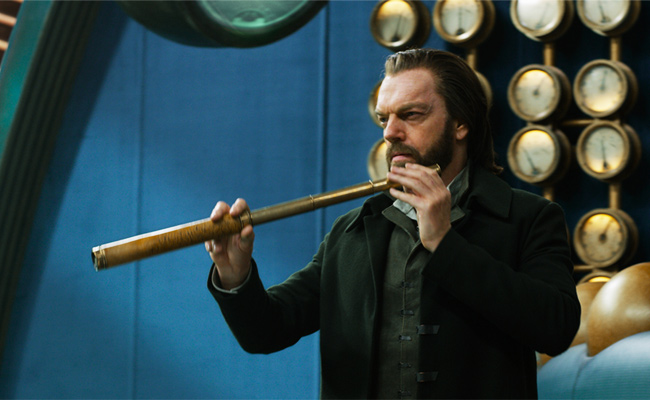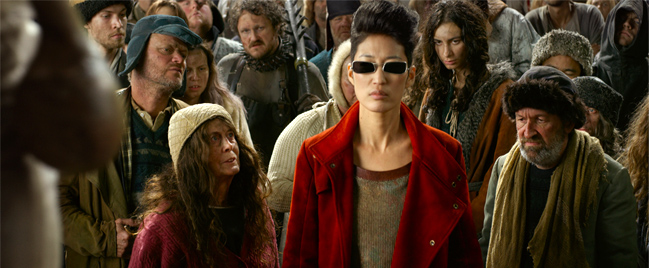
There’s a special place in my heart for ambitious, megabudget disasters. I respect what Valerian And The City Of A Thousand Planets could’ve been, if not what it was, and I still think about Jupiter Ascending on a regular basis. These are the kinds of movies that generally win Razzies, which is why I’ve always hated the Razzies. Taking a big swing is something to be admired, even if it doesn’t always work out. There are movies much more deserving of scorn, projects like Tomb Raider, craven IP maintenance from the start that you start to forget before they’re even over. Those are the projects that deserve Razzies.
Mortal Engines at least seems ambitious. Yet it’s hard not to feel like it was released at the wrong time. In the midst of a crowded award season comes a huge CGI steampunk adventure based on a book most of us probably haven’t read. I didn’t see it, and not out of any particular malice. I just had to allocate my time elsewhere.
It seems I wasn’t the only one. The $110 million Peter Jackson-produced adventure earned only $7.5 million in North America this weekend, to go along with 28% recommended on Rottentomatoes and a B- Cinemascore. Universal and Media Rights Capital are reportedly looking at a $100 million loss.
It may not have worked out, but at least it looked… interesting? Definitely, it was full of… stuff!
I thought it was at least worth finding out what was going on with Mortal Engines before it goes away, so I’m returning to Plot Recreated With Reviews, a feature in which we attempt to piece together the entire plot of a movie using nothing but summary quotes (no analysis!) from reviews. In my mind, the best way to experience a failed movie is having it explained to you by exasperated critics.

—
“Mortal Engines” begins with the usual voiceover informing us how (Rogert Ebert.com)
the world has been ruined by a “60-minute war” that took out much of civilization, (Arizona Republic)
sending technology back to the Victorian era as it did so. That’s right. Grab your goggles, tinkerers and tea-sippers: It’s steampunk time! (AV Club)
Now the world itself, in the 38th century, (LA Times) is unmoored, as predator cities scavenge the globe for what’s left of its resources. (RogerEbert.com)
Following the principles of something called Municipal Darwinism, (LA Times) London plows across Europe on caterpillar tracks, chewing up smaller towns in its path. (New Yorker)
How this engineering feat was achieved is not addressed. (RogerEbert.com)
London is ravenous, yet not genocidal. Residents of swallowed towns are offered refuge in the city, although a public announcement warns that “children may be temporarily separated from parents.” (NPR)
The residents of those other cities are then absorbed into London’s lower classes, who live on the bottom tier, next to its eternally churning engine. (AV Club)
The upper tiers are populated by historians, traders, engineers, and navigators (AV Club) in frock coats festooned with gold braid. (Washington Post)
The communities on board London have museums filled with ancient junk from our current times; known as “The Screen Age,” our era is reduced to statues of Minions (Detroit News), referred to as “the American deities,” in a cute, if all too rare joke. (Washington Post)
It was the age of rust and scowls. (Seattle Times)
London is hauling ass and hunkering down on a much smaller “Romanian mining town,” hoping to steal its salt. On that town is Hester Shaw (Hera Hilmar) (RogerEbert.com) introduced wearing a red bandanna that hides a scarred face. (LA Times)
Within the first 10 minutes alone, we meet nearly a dozen characters who seem to have relevance, but then fail to appear on-screen long enough for us to develop our own feelings for them. (Globe And Mail)
In her orphaned girlhood [Hester] was adopted by a member of something called “The Lazarus Brigade,” undead robots with high-level superpowers who always get what they want. Her adoptee, Shrike, played by Stephen Lang with a substantial overlay of CGI, was touched by her promise that she would allow him to turn her into a similar robot. But Hester reneged and Shrike went apeshit, or whatever the equivalent of apeshit is for super-powered undead robots. (RogerEbert.com)
A comely youth named Tom (Robert Sheehan) (New Yorker), a young historian building up a collection of “the Ancients’” weaponry (Roger Ebert.com) teams up with Hester. (New Yorker)
Tom is a history-museum underling, but with backup skills as a fighter pilot that will prove useful. (NPR)
Hester and Tom (Washington Post), who somehow wins the affection of tough-minded Hester despite being an ineffectual pest for most of the picture (Seattle Times), find themselves on the side of an underground resistance manned by a mini-United Nations of insurgents. You know they’re the good guys because they’re diverse. (Washington Post)
Their enemy is Thaddeus Valentine (Hugo Weaving), (New Yorker) the guy who slashed Hester’s face and gave her those scars (Seattle Times), who is developing a weapon so secret that he houses it in the dome of St. Paul’s Cathedral. (New Yorker)
Thaddeus intends to destroy something a lot like the Great Wall of China, thus allowing London to pillage a pan-Asian land with a culture that draws mostly from China and India, but with a population that includes people of apparent African descent. (NPR)
And so the two bickering exiles begin a journey back to London in order to stop Thaddeus from dooming them all — a journey that will see them ride a house that looks like a rock and moves like a centipede, travel to a hilariously ill-conceived floating market so combustible that it can be destroyed by a single match, and spare a few minutes for a subplot involving some minor characters back in London who are so underwritten they hardly merit a mention. (Indiewire)
The pair survive on found food like antediluvian Twinkies from back in the day, causing Hester to knowingly proclaim, “the food of the ancients is indestructible.” (LA Times)
They also meet some wild and crazy characters like Anna Fang (Jihae), a hip aviatrix with a price on her head who’s also the head of something called the “Anti-Traction League.” (LA Times)

As an outlaw, the singer-composer Jihae wears shades that appear borrowed from the wardrobe department for “The Matrix.” (New York Times)
Thaddeus frees the very insistent and very destructive Shrike from a floating prison and off he goes to collect on Hester’s promise. He destroys so much in his path it’s a wonder that Hester’s many newfound friends even keep her around, but lucky they do, because, surprise, she holds the key to dismantling Thaddeus’ super weapon. (RogerEbert.com)
It’s not just that Shrike stalks the earth like a lumbering Boris Karloff parody, nor is it that his name bears an unfortunate sonic resemblance to “Shrek!” when it’s screamed out loud in terror, but the creature also has a complicated backstory with Hester that takes up a good deal of the film’s middle third. (Variety)
The dialogue, peppered with well-worn catchphrases like “We didn’t start this, but we will finish it…” (Washington Post)
“We should never have gone into Europe,” frets Magnus Crome, the vaguely imperial ruler of London. (New York Times)
There’s a character named “Bevis Pod…” (Indiewire)
…a plane whose wings resemble an undergarment, a floating city with fragile bridges and walls (New York Times)
…grimy set design, laser beams of mass destruction, and reliance on passing aircraft ex machina, (AV Club)
…product placement overrides any aesthetic (New York Times)
and characters leap unfeasibly out of planes. (Time Out London)
There’s even a scene in which a plucky rebel (Robert Sheehan) pilots a small fighter plane into the belly of the Death-Star-like behemoth around which the action swarms, exhaustingly. (Washington Post)
A more mercenary hand would have cut the Shrike plot line, or the majestic moment where Weaving commands his London crew “prepare to ingest!” (Vulture)
The movie devolves from promising to unwieldy, then baffling, then exhausting, then finally unintentionally hysterical. (Variety)
It all ends with a big, eye-numbing battle and a lot of purple light beams shooting into the skies, as most blockbuster-sized movies do these days. (Indiewire)
—
So many movies end with shooting lasers and stuff at the sky these days. It’s like we’re compelled to try to relive the moment when we killed God. Anyway, happy holidays.
Vince Mancini is on Twitter. You can find his archive of reviews here.






